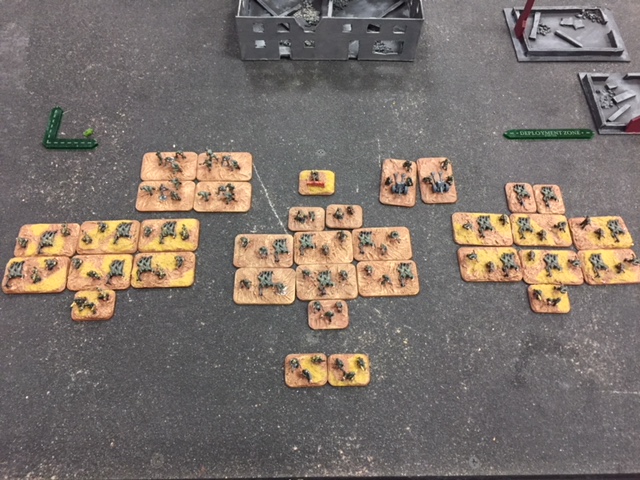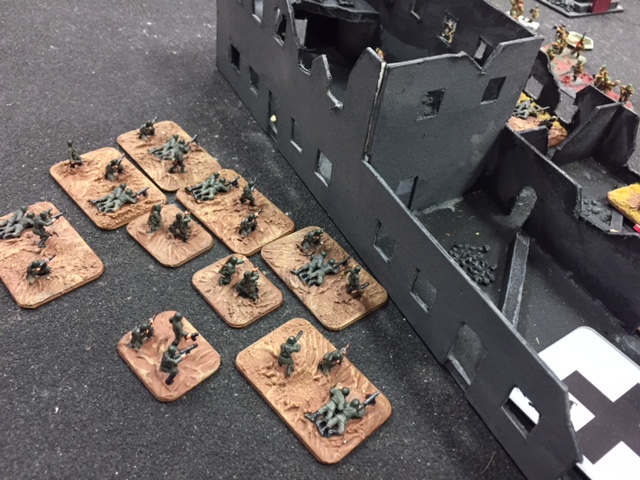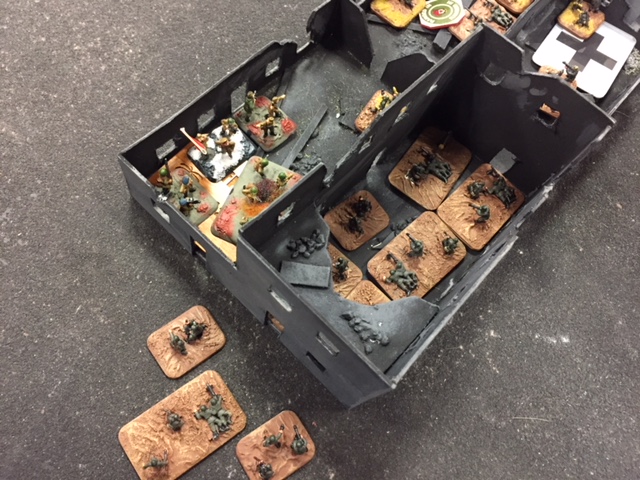The Square – An Enemy at the Gates City Fight AAR
by Tom Burgess
My good friend, Battle Buddy Ed, and I recently set up a City Fight game from the new Enemy at the Gates book. Ed brought his Soviets and I played Germans in “The Square” mission. The City Fight missions are played on small 3’ by 2’ boards so we decided to experiment with this new mission with 50 point forces. We also decided to keep this as an all infantry fight and agreed to take no tanks.
My Germans were based on a Grenadier Formation with an HQ, two midsize Grenadier platoons, an HMG attached to one of the Grenadier platoons, a full Assault Pioneer platoon, a four-tube 81mm mortar platoon, two 150mm infantry guns and a sniper.

Ed’s Soviets were based on a Hero Rifle Battalion with HQ, a large Hero Rifle Co, a large Storm Group, a small SMG Company, a three tube 82mm mortar unit, and a six HMG unit.

We rolled off for attacker with my forces being the defenders. Looking at Ed’s Storm Group, I immediately started to get a sinking feeling about my prospects. With Ed’s elite Storm Group starting just 12” off the building complex I would be defending, it was a very real possibility that I would be assaulted on turn 1!

The board set up was easy like it is for all City Fight missions. You really only needed a couple of key buildings in these missions as the rest of the table is all rubble that provides concealment and bullet-proof cover! This was a bit confusing in this mission tough. “The Square” implies that the main battle area should be an open city square. There is supposed to be a “fountain” or other similar low bulletproof terrain feature in the center of no man’s land in this mission, but that did not make sense because the entire table was low bullet-proof terrain. Ed and I decided that we should play to the text rather than the implied theme.

Another question we had was would targets in low terrain still have bulletproof cover from shooters in high terrain, i.e. the second floor and up in the buildings. Since low terrain does not conceal from high terrain we decided that bullet-proof cover would also not imply in that case. If we are correct, this will make upper floors a premium in our building models. Most building/rubble models don’t have a lot of floor space above the ground level. We’ll want more now.

As the defender in this mission, I had to deploy as “outposts” which meant I had only 40% of forces on the table and the rest in delayed scattered reserve. But that brought up another question. With the defender’s table edge only being 24” across, being scattered with the normal ability to come in 16” from a corner effectively made “scattered reserves” irrelevant. Ed and I could not find any reference to the “scattered” corner distance or reserve entry being anything less than the standard 16”. We just decided to half it to 8” so it would have some effect.
For my forward outpost unit, I took both Grenadier platoons and the Sniper. The Assault Pioneers would be a great counter attack unit coming out of reserves while the HQ and artillery support were luxuries I just could not afford. I deployed a few teams forward of the building as I hoped this would keep Ed from consolidation in the building as I planned to break off after the first round of combat. I’m not sure this plan would work as the building fighting rules seem clear enough but subsequent rounds of combat that started outside of the building but rolled into the building seem less clear.

Ed would use the Zulu “Horns of the Buffalo” formation sending is Storm Group in on his right, backed up by the SMGs and his Hero Rifle Company in on his left. His HMGs would provide a base of supporting fire for both units from the center.

In turn one, Ed moved up his assault elements on both flanks. His mortars, despite being pre-ranged in on the building’s center room failed to hit anything. I advised Ed to ty a “Follow Me” to get in assault range on the first turn but he elected to keep shooting on the move with his twin pronged assault elements.

I managed, without the Formation Commander’s presence to rally both my pinned platoons in turn one. I opened up with all I could trying to prioritize hits on flamethrowers and Komissars.

In turn two, Ed brought in his assaults on the left and the right edges of the building. I was very lucky and managed to stop both with defensive fire.

On turn three, Ed was unable to rally his pinned Hero Rifle Company on his left, but the Storm Company was able to close in on his right and push the Grenadiers there into adjacent rooms. Though the Grenadier was bloodied, it rallied from its pin and attacked back into building left corner room. This destroyed must of what was left of the Storm Group, but the Hero SMGs were coming right in behind them.

My Assault Pioneers came in from reserves on turn three. Even though I rolled the worst scattered reserve entry point that I could for them, a terrain dash followed by successful Follow Me movement order got the pioneers right where I needed them anyway.

In turn four, the Hero Rifle Company remained pinned again. With the loss of the Komissar and the Formation Commander being on the opposite side of the battlefield, it was clear these troops were just not going to get going again. Ed really needed that Blocking Detachment command card here so those HMGs could get them moving again.
However, the small Hero SMG Company took over from the depleted Storm Group and crashed back into the left corner room. The assault destroyed what was left of that Grenadier platoon. But in my part of turn four the Assault Pioneers had no problem destroying the Hero SMGs and the Soviet Formation Commander.

We still had not had it turn six, but we decided that with Ed’s main effort on his right being completely destroyed and his secondary effort on his left being unable to unpin that the game was effectively over for the Soviets.

We thought this was an interesting and exciting battle, but we still are unsure about some aspects of the new City Fight mission rules. I really like the idea of a small point small battlefield game alternative for Flames of War. This lets players play battles on virtually any table to top. This will be a great boon for gamers who don’t have permanent large gaming tables available.
The simplification of terrain makes it easy and cheap for players to set up these City Fight games, but as you can see in the article photos I actually think a bit of visually modelled rubble really helps the look of the game in areas of the board that would otherwise just be flat and featureless.
I highly recommend giving the new missions a try if you’re looking for something new in your Flames of War gaming experiences.
